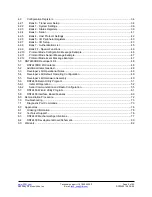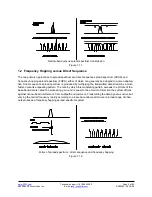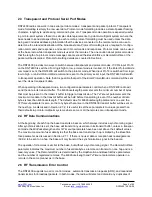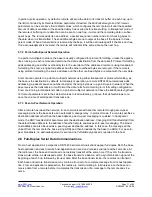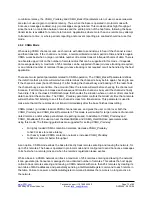
www.RFM.com
Technical s1.678.684.2000
Page 15 of 82
©2009 by RF Monolithics, Inc.
E-mail:
DNT2400 - 08/18/09
DNT2400 has several configuration parameters that allow latency and throughput to be optimally bal-
anced to the needs of an application.
2.10.1 TDMA Throughput
For TDMA channel access, throughput and latency are controlled by the RF data rate, the serial port
baud rate, the BaseSlotSize, the HopDuration, and the number of remotes. A wide range of throughput
and latency combinations can be obtained by adjusting these parameters. The throughput of a radio in a
TDMA network is simply:
Number of bytes per hop/Hop Duration
For the base, the number of byes per hop is controlled by the BaseSlotSize parameter so the throughput
of the base radio is:
BaseSlotSize/HopDuration
Note that if fewer bytes than the BaseSlotSize limit are sent to the base radio by its host during the hop
duration time in transparent mode, the observed throughput of the base radio will be reduced. If the base
is in protocol mode, it will wait until a protocol formatted message is completely received from its host
before transmitting it. If the message is not completely received by the time the base transmits, the base
will wait until the next hop to transmit the message. The throughput for each remote is:
RemoteSlotSize/HopDuration
In a TDMA mode, the RemoteSlotSize is set automatically based on the number of remotes and the
BaseSlotSize. Note that the base radio always reserves BaseSlotSize amount of time in each hop
whether or not the base has user data to send.
To help select appropriate parameter values, RFM provides the DNT Throughput Calculator utility pro-
gram (DNTCalc.exe). This program is on the development kit CD. Enabling encryption (security) adds
additional bytes to the data to be sent but the Calculator has a mode to take this into account.
2.10.2 Polling Throughput
In polling mode, the application sends data from the base to a specific remote, which causes the remote
and/or its host to send data back to the application. The network operates like a point-to-point network in
this case. In polling, the HopDuration should be set just long enough to accommodate a base transmis-
sion up to the limit allowed by the BaseSlotSize parameter, plus one remote transmission up to the limit
allowed by the CSMA_RemtSlotSize parameter. These slot sizes and the hop duration set the polling
throughput as in TDMA channel access.
The throughput in Polling mode is also determined by the amount of time it takes for the remote host
device to respond to the poll. For example, consider the situation where a remote host device communi-
cates with the DNT2400 at 38.4 kb/s, receives a 16-byte poll command, and takes 1 ms to generate a 32-
byte response which it then sends to the DNT2400. Sixteen bytes over a UART port is 160 bits using
8,N,1 serial parameters. Sending 160 bits at 38.4 kb/s takes 4.2 ms. Add 1 ms for the host device to
process the command and begin sending the 32-byte response. The 32-byte response takes 8.4 ms to
send at 38.4 kb/s, for a total turnaround time of 13.6 ms. This amount of time could be added to the base
and remote slot times to allow the entire transaction to take place in a single hop. However, except at the
38.4 kb/s over-the-air data rate, this is likely to be much longer than the base and remote slot times.
Thus, in practice, lengthening the hop duration to complete the transaction in a single hop doesn’t really




